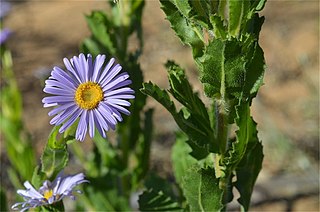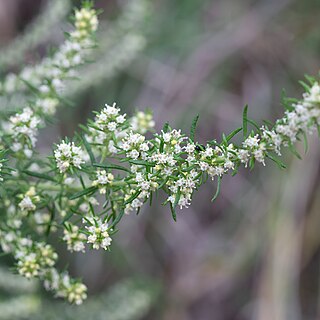
Olearia axillaris, commonly known as coastal daisy-bush, coast daisy-bush or coastal daisybush is a species of flowering plant in the family Asteraceae and is endemic to coastal areas of Australia. It is an erect, bushy shrub with densely cottony-hairy branchlets, aromatic, linear to narrowly elliptic or narrowly lance-shaped to egg-shaped leaves with the narrower end towards the base and small white and yellow, daisy-like inflorescences.

Olearia pimeleoides, commonly known as pimelea daisy-bush, is a species of flowering plant in the family Asteraceae and is endemic to southern continental Australia. It is an erect shrub with elliptic, linear or lance-shaped leaves, and white and pale yellow, daisy-like inflorescences.

Olearia ramulosa, commonly known as twiggy daisy-bush, is a species of flowering plant in the family Asteraceae and is endemic to south-eastern Australia. It is a shrub with narrowly elliptic, linear or narrowly egg-shaped leaves, and pale blue, mauve or white and yellow, daisy-like inflorescences.

Olearia phlogopappa commonly known as the dusty daisy-bush or alpine daisy-bush is a species of flowering plant in the family Asteraceae that is commonly found in eastern New South Wales, Victoria and Tasmania. It is a small shrub with greyish-green foliage, daisy-like flowers in white, pink or mauve that can be seen from spring to late summer.

Olearia glutinosa, commonly known as sticky daisy-bush, is a species of flowering plant in the family Asteraceae and is endemic to south-eastern Australia. It is an erect, bushy, glabrous shrub with linear leaves and mauve, pink or white and yellow, daisy-like inflorescences.

Olearia myrsinoides, commonly known as silky daisy-bush or blush daisy bush, is a species of flowering plant in the family Asteraceae and is endemic to south-eastern Australia. It is a spreading shrub with hairy branchlets, egg-shaped to elliptic leaves with toothed edges, and white and yellow or mauve, daisy-like inflorescences.

Olearia mooneyi, commonly known as pumpkin bush, is a species of flowering plant in the family Asteraceae and is endemic to Lord Howe Island. It is a shrub or small tree with hairy, elliptic to egg-shaped leaves with the narrower end towards the base, and white and pale yellow, daisy-like inflorescences.

Cassinia trinerva is a species of flowering plant in the family Asteraceae and is endemic to south-eastern Australia. It is an erect shrub or small tree with hairy stems, narrow lance-shaped leaves, and flower heads arranged in dense corymbs.

Olearia decurrens, commonly known as the clammy daisy bush, is a species of flowering plant in the family Asteraceae and is endemic to arid, inland Australia. It is a glabrous, sticky, twiggy shrub with narrow egg-shaped to linear leaves sometimes with toothed edges, and white and yellow, daisy-like inflorescences.

Olearia brachyphylla is a species of flowering plant in the family Asteraceae and is endemic to southern continental Australia. It is a densely-branched, aromatic shrub with woolly-hairy stems, oblong to egg-shaped leaves with the narrower end towards the base and small white and pale yellow, daisy-like inflorescences.
Olearia burgessii is a species of flowering plant in the family Asteraceae and is endemic to south-eastern New South Wales. It is a shrub with scattered elliptic to egg-shaped leaves with the narrower end towards the base, and white and yellow, daisy-like inflorescences.

Olearia glandulosa, commonly known as swamp daisy-bush, is a species of flowering plant in the family Asteraceae and is endemic to south-eastern Australia. It is a slender, erect, glabrous shrub with sticky, narrowly linear leaves and white or pale blue and yellow, daisy-like inflorescences.
Olearia incana is a species of flowering plant in the family Asteraceae and is endemic to southern Australia. It is a shrub with narrowly elliptic or wedge-shaped leaves and white and pale yellow, daisy-like inflorescences.

Olearia lanuginosa is a species of flowering plant in the family Asteraceae and is endemic to southern Australia. It is an erect shrub with egg-shaped leaves and white to mauve and yellowish, daisy-like inflorescences.

Olearia passerinoides, commonly known as slender daisy bush, is a species of flowering plant in the family Asteraceae and is endemic to southern continental Australia. It is a slender, sticky shrub with linear leaves, and white or pale mauve and mauve or pink daisy flowers.

Olearia rudis, commonly known as azure daisy-bush, is a species of flowering plant in the family Asteraceae and is endemic to eastern Australia. It is a usually short-lived shrub with crowded elliptic or egg-shaped leaves, and pale blue, mauve or purple and orange, daisy-like inflorescences.

Olearia speciosa is a species of flowering plant in the family Asteraceae and is endemic to Victoria in Australia. It is a straggly, open shrub with egg-shaped to elliptic leaves, and white and yellow or brownish, daisy-like inflorescences.

Olearia subspicata, commonly known as spiked daisy bush or shrubby daisy-bush, is a species of flowering plant in the family Asteraceae and is endemic to continental Australia. It is an erect shrub with more or less linear leaves and white and yellow, daisy-like inflorescences.

Olearia tubuliflora, commonly known as rayless daisy-bush, is a species of flowering plant in the family Asteraceae and is endemic to south-eastern continental Australia. It is a slender, erect shrub with linear or narrowly elliptic leaves and yellow, daisy-like inflorescences but with the ray florets lacking a ligule.

Olearia teretifolia is a species of flowering plant in the family Asteraceae and is endemic to south-eastern Australia. It is a bushy shrub with lance-shaped, egg-shaped or elliptic leaves arranged in opposite pairs, and white and yellow, daisy-like inflorescences.


















